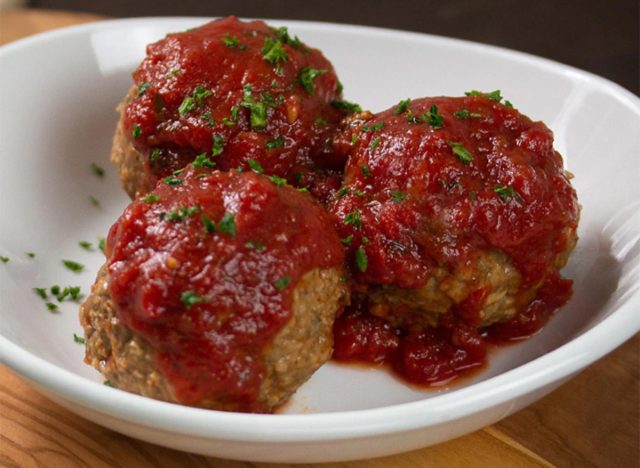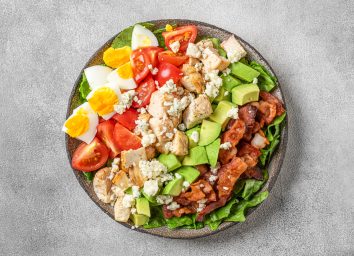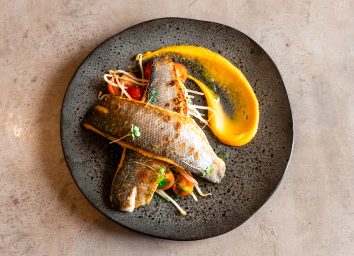
Olive Garden is notorious for its cheesy pasta dishes; "never-ending" soup, salad, and breadsticks; and generous portions. But despite the restaurant's welcoming, family feel, its menu has a nefarious amount of unhealthy options that truly go over the top when it comes to reasonable levels of fat, sodium, and carbs.
The Italian restaurant chain's menu showcases how carbs have gotten a bad reputation. The oversized pasta portions and creamy, high-calorie sauces make most of the dishes on the Olive Garden menu so unhealthy that you'll consume more fat, saturated fat, and sodium than is recommended to eat in an entire day. Even healthy proteins, like shrimp, are made unhealthy after being drowned in a creamy sauce. The dessert menu isn't much better, with many of the menu options having over 100% of your daily recommended limit of added sugar.
Below you'll find eight of the Olive Garden menu items dietitians recommend that you skip—or if you're truly craving the option—split with friends or take home at least half. There are a handful of better-for-you options on this menu, but it does take some investigating of the menu to find them. Luckily, we've done that work for you with these 8 Healthiest Dishes To Order at Olive Garden.
Shrimp Fritto Misto

"This appetizer has more calories than many people consume in a whole meal and has over double the amount of sodium a person should have in a day," says Ginger Hultin, MS, RDN, CSO, Seattle-based registered dietitian nutritionist, and author of the e-book, Meal Prep for Weight Loss 101. "This salt level could be a problem for anyone watching their blood pressure," she adds. Hultin recommends opting for any other appetizer option on the menu as they are all lighter in both calories and sodium.
Meatballs Parmigiana

According to Mascha Davis, MPH, RDN, Registered Dietitian Nutritionist and author of Eat Your Vitamins, "The Dietary Guidelines for Americans recommend keeping saturated fat intake less than 10% of total calories, which would equal roughly 20 grams of saturated fat in a 2,000-calorie diet. This appetizer alone contains 40 grams of saturated fat, which is double the recommendation!" Davis explains that "most of the saturated fat comes from the main ingredients that make up this dish, such as the meat and cheese." You're better off opting for lower calories and lower saturated fat appetizers.
Ravioli Carbonara

"While this menu option sounds like it might taste good, it also has almost three times the recommended limit of saturated fat of 63 grams and contains small amounts of trans fat (2.5 grams), both of which could be risky for your heart health," explains Davis.
Chicken Tortellini Alfredo

At close to the daily recommended calories of 2,000 (based on the U.S. average), "this meal would provide enough calories for an entire day plus twice the amount of fat grams," says Lisa Andrews, MEd, RD, LD owner of Sound Bites Nutrition. Instead, Andrews recommends "If you must have it, split it three ways or eat a quarter of it and save the rest for lunch and dinner over the course of a few days."
Shrimp Alfredo

Although shrimp is a very low-calorie protein, when it's served with a high saturated fat sauce the calories and saturated fat go through the roof. This dish provides 250% of the recommended daily amount of saturated fat and 70% of the recommended daily maximum of sodium. This is without any sides, salads, drinks, or desserts—or any other meals during the day.
Tour of Italy

Although this dish sounds amazing, Davis says that you should slowly savor each part of the dish instead of ordering this dish. With 3 different foods in one dish, you'll get over double the recommended amount of saturated fat and close to 150% of the recommended daily amount of sodium.
Meatballs

"For a simple side dish, this one is loaded with 2 grams of super unhealthy trans fats and 40 grams of total fat," says Davis. "Despite being a side, it's in the same league as the entrees and appetizers with high amounts of fat (more than half of the daily recommended amount)."
Chocolate Brownie Lasagna

"Desserts are delicious and taste great, but this one is a 'no-go' in my book," David exclaims. "The sugar alone adds up to roughly half a cup's worth or over 100 grams!" The daily recommended amount for added sugar is a maximum of 10% of your daily calorie intake which can equal up to no more than 50 grams per day, and Davis says that too much sugar could lead to a higher risk for certain diseases and health complications.









